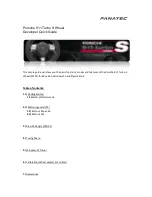
WARNING! (Continued)
•
Make certain that the load is secured in the trailer
and will not shift during travel. When trailering
cargo that is not fully secured, dynamic load shifts
can occur that may be difficult for the driver to
control. You could lose control of your vehicle and
have an accident.
•
When hauling cargo or towing a trailer, do not
overload your vehicle or trailer. Overloading can
cause a loss of control, poor performance or dam-
age to brakes, axle, engine, transmission, steering,
suspension, chassis structure or tires.
•
Safety chains must always be used between your
vehicle and trailer. Always connect the chains to
the frame or hook retainers of the vehicle hitch.
Cross the chains under the trailer tongue and
allow enough slack for turning corners.
(Continued)
WARNING! (Continued)
•
Vehicles with trailers should not be parked on a
grade. When parking, apply the parking brake on
the tow vehicle. Put the tow vehicle transmission
in PARK. Always, block or
ⴖ
chock
ⴖ
the trailer
wheels.
•
GCWR must not be exceeded.
•
Total weight must be distributed between the tow
vehicle and the trailer such that the following four
ratings are not exceeded:
1. GVWR
2. GTW
3. GAWR
4. Tongue weight rating for the trailer hitch uti-
lized. (This requirement may limit the ability to
always achieve the 10% to 15% range of tongue
weight as a percentage of total trailer weight).
5
STARTING AND OPERATING
357
Summary of Contents for 2010 Nitro
Page 2: ......
Page 6: ...6 INTRODUCTION...
Page 116: ...116 UNDERSTANDING THE FEATURES OF YOUR VEHICLE...
Page 117: ...3 UNDERSTANDING THE FEATURES OF YOUR VEHICLE 117...
Page 118: ...118 UNDERSTANDING THE FEATURES OF YOUR VEHICLE...
Page 181: ...INSTRUMENT CLUSTER 4 UNDERSTANDING YOUR INSTRUMENT PANEL 181...
Page 262: ...262 UNDERSTANDING YOUR INSTRUMENT PANEL...
Page 316: ...316 STARTING AND OPERATING...
Page 364: ......
Page 378: ......
Page 446: ......
Page 457: ...INDEX 10...
















































